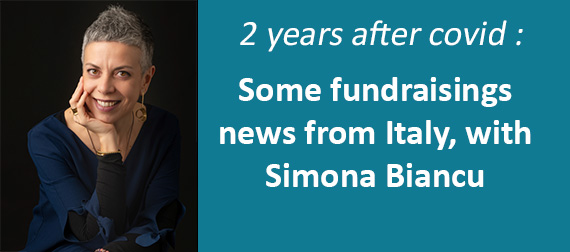2 years after covid : Some fundraisings news from Italy
Publié le 07.09.2022
Interview avec Simona Biancu sur l'impact de la crise Covid-19 sur la générosité en Italie, les nouvelles habitudes de dons, les initiatives inspirantes, le moral des fundraisers et les enjeux à venir. (Article en anglais)
Le 19 mars 2020, nous avions réalisé la transcription d’un article de Simona Biancu, consultante italienne en fundraising sur la crise Covid-19 qui avait commencé par impacter fortement l’Italie : “Chronique depuis l’Italie pendant le Coronavirus“. Nous avons voulu prendre de ses nouvelles, 2 ans après, sur l’impact de la crise Covid-19 sur la générosité en Italie, les nouvelles habitudes de dons des Italiens, les initiatives inspirantes, le moral des fundraisers et les enjeux à venir pour notre secteur :
- 2 years of covid crisis In Italy, what is the impact on generosity?
- What are the news habits of giving from the Italians?
- How have the fundraisers succeeded to work with the crisis? Do you have any inspiring initiative to share with us?
- What is the current situation for the fundraiser profession in Italy?
- What are the main challenges to fulfil for the fundraising sector in the next years?

1. Two years of covid crisis In Italy, what is the impact on generosity?
The pandemic has upset, in a profound way, in some cases calling into question the basics of our pre-pandemic lives, all aspects of our society, from the economy to social life.
Philanthropy and, more broadly, giving, was strongly influenced by the exceptional effects of the two “black swans”, as many analysts define them, which marked this beginning of the decade: the pandemic and the outbreak of the War in Ukraine.
Coming to the specific fundraising industry, the most recent surveys show that in 2021 as many as 7 out of 10 Italians declared that they had donated at least once in their life (+ 4% compared to the previous year) and, compared to 2020, the trust of donors towards non-profit organizations has grown.
Analyzing the effects of the pandemic on the Italian nonprofit organizations, 46% of the nonprofits interviewed stated that the lockdowns affected the possibility of raising funds (the worst period was the first lockdown, for the 53% of respondents) and 43% expected to close 2021 with a further decline. Also from the point of view of services, a quarter of them found themselves forced to suspend them totally or partially. These figures, of course, don’t consider those organizations less orientated to development through structured fundraising activities.
In terms of donations using the web, among the most interesting figures from these 2 years, data show that even in 2021, 37% of Internet users (40% in 2020) declared that they did not support an NPO that they usually supported before COVID, presumably choosing a reality more connected to the emergency; while 60% of those interviewed recently took action in favor of the Ukraine emergency (mainly with donations in kind, as opposed to those in cash, which in any case was chosen by just under one out of three donors).
Going beyond the mere figures, what emerges from these 2 years are, from my perspective, three main trends:
- an increasing in the awareness of the importance and crucial role of the nonprofit sector – I name it including the whole field: culture, education, animal welfare, beyond the social area – for the management and development of the whole country. What seemed evident to those closer to the nonprofit field before the pandemic, is now a shared awareness for the general public.
- people give when and where it seems more needed. This may be somewhat tautologic but, in fact, we saw a huge amount of spontaneous fundraising initiatives during the first lockdown, because of an emergency. Of course, emergencies inspire generosity; however, more broadly, I think that people are more generous that it seems. The point is, for NPOs, to make it clear their mission, their “reason why” and how they impact on their field of action. It’s a question of be more engaging, including donors and prospects into the storytelling, not just considering them as a “counterpart” of their activities.
- disintermediation emerged as a matter of fact: many donors gave regardless an appeal from an organization. The donated because they wanted to help other people – this was during the pandemic, and it was the same for the most recent Ukrainian war. It’s something that NPOs must deal with as one of the possible ways for people to support causes: rather than being a risk to lose donors, it can be an opportunity to expand the constituency, if managed and included in the whole development strategy.
2. What are the news habits of giving from the Italians?
From the point of view of the propensity to donate, the data seem to show a certain stability in the number of donors. As a corollary to this data, one of the surveys recorded a contraction in the population that claims not to have made any donations (not even informal), which goes from 55% to 64%.
Among the causes, scientific research and support to fragile people are the most popular, followed by hunger, poverty, animals, health, and humanitarian emergencies.
My opinion is that giving back was the key factor raised during the pandemic and still a crucial factor that shapes the “reason why” of giving. In some ways, the pandemic showed how we are interconnected, making it real the motto “nobody saves him/herself alone”. The Ukrainian crisis reinforced this orientation, in my view, due to the proximity of that country in terms of geographic location and the identification with people that, suddenly, found themselves in a scary, unimaginable situation.
I think that everyone realized how much each of us is a part necessary for the others – for each of the others. And how much generosity and giving are an essential part of everyone’s lives. Even when, sometimes, we don’t pay attention to them.
3. How have the fundraisers succeeded to work with the crisis? Do you have any inspiring initiative to share with us?
From my point of observation, I see many fundraisers even more passionate at their causes. These years have seen many changes – working from home, sometimes totally isolated; two major international crisis and the consequent need to adjust programmes, conceive new ones and, at the same time, keep the teams motivated and focused; an increasing of the disintermediate giving, which is an interesting phenomenon that, in any case, doesn’t make the role of fundraisers useless but brings new questions on the tale.
I would mention two initiatives which, from different perspectives, show to what extent fundraising can be a vehicle capable to represent a vision and provide the tools to make it happen.
The first one is about the Italian fundraising taskforce for hospitals during Covid-19, launched by Job4good, the Italian Third Sector job matching platform focused on Human Resource and professional training, in partnership with ASSIF – Italian Association of fundraisers, that was a totally volunteer-base initiative that helped raising 950.000 euros.
During the most critical period of Covid-19, Italian hospitals were facing an unprecedented, highly challenging need of funds and devices to manage the reaction to hospitalisation and congestion of ICU Departments throughout the country. In light of a shared desire to cooperate in terms of professional support for all those hospitals that had never manage fundraising, more than 40 fundraising and communications professionals donated their time and expertise to ensure that the Italian public’s desire to help at this challenging time is safely and professionally directed, to create the best possible results from all of the spontaneous campaigns that have arisen during this crisis.
It has been considered one of the most effective best practices in the Italian fundraising industry as well as a way to follow for potential, similar situations.
The case of the “fundraising taskforce for Hospitals during Covid-19” still is a helpful example to encourage fundraisers to take an active role – not just within the not-for-profit sector but also towards public and private industries. This project offered a perspective focused on how fundraisers can really be a “force for good” capable to advance their contexts.
You can find out more at https://sofii.org/case-study/italys-fundraising-taskforce-for-hospitals
The second initiative I would like to mention is one that saw my firm, ENGAGEDIN, involved professionally in a consultancy to support the development of the fundraising strategy for the Museo Egizio (set in Torino, Italy), one of the most important museum institutions both nationally and internationally.
Together with the museum staff, we decided to launch their first fundraising campaign at Christmas 2020, at a time when museums were closed due to the pandemic. The focus, then, was exclusively on a digital fundraising campaign, coining a claim that represented on the one hand the reality of the Museum and its social and cultural impact and, at the same time, a call to action to donors inviting them to take care of the Museum – Take care of ME (ME stands for Museo Egizio) was such claim.
In just a few days, using the dedicated landing page (set up by iRaiser), we have developed the concept of the campaign, the messages, the claims, the tools to be used – digital yes, but mixing them up to consider the different panels of prospect donors and, what’s important, also involving the governance to personally take care of the appeals. In a few days, the campaign raised more than 21thousand euros: not bad, for being a “first time” and, moreover, in a period of great difficulty due to the impossibility of opening the Museum to visitors. Beyond money, however, that campaign laid the basis for the fundraising strategy of the Museum, setting up a working method ran by a dedicated staff, using fundraising (and digital) techniques for the first time. The starting point of the development strategy through fundraising, to put it shortly.
The concept of the campaign, which has become that of campaigns for one-off donors, is still active and generates new donors- you can find it here.
4. What is the current situation for the fundraiser profession in Italy?
The pandemic has, to some extent, legitimized fundraising as a structured, not episodic, way to secure development for nonprofit organizations.
Despite the number of initiatives and the current use of the term “fundraising”, however, the fundraisers’ profession is not so well known in its real potentialities and implications by the general public.
A lot of work must be done to disseminate what I call “a contemporary giving culture” on the Italian territories.
ASSIF, the Italian Association of Fundraisers of which I am the vice president and delegate to internationalization, is highly committed to work on the dissemination and promotion of fundraising: among the other initiatives to promote it as a vehicle of change and sustainability, we organized the first ASSIF major event, Fundraising To Say, that took place at the beginning of September. More than 300 fundraisers and social communicators gathered in Sicily for a 4-day event of talks and networking, an opportunity to meet professionals from across Italy. It was a great source of inspiration and learning for the participants, having the opportunity to mixed with the local institutions and talk about fundraising also with non-fundraisers.
The Festival del Fundraising is another “traditional” appointment for fundraisers.
There are several training opportunities across the whole country.
Despite the efforts in terms of outreach and training, however, I think that there’s still a lot to be done to inform and communicate what a fundraiser really works on – not just seeking for money but also working on the strategic side and, from an overall perspective, making change real.
5. What are the main challenges to fulfil for the fundraising sector in the next years in Italy ?
I think that the challenge for the next years is to make the nonprofit field attractive for professionals even from different industries – for-profit, e.g.
It’s something that, in some cases, already happens; nonetheless, a certain vision related to nonprofit as a field where it is less desirable and challenging to develop a career path, should be overcome, also considering how the sector contributed to handle both the pandemic and the Ukrainian war crisis, just to mentions the two most recent major crisis – but it’s a strategic role that shape the everyday life for everyone, from the health to culture or animals, education, poverty and lots more.
I would say that, on the one hand, there is a need to develop skills and competencies for professionals; on the other hand, the goal should be to communicate what fundraising is and the way it contributes to development, to make it more attractive for professionals and generate more exchanges and new visions that people that come from different industries can bring to the table.
Qui est Simona Biancu ?
Fundraising and strategic philanthropy consultant and trainer, founder and CEO of ENGAGEDin, a consultancy firm that works internationally in fundraising, strategic philanthropy, Board development.
Simona got a post-graduate Master in Fundraising at Università di Bologna and completed training attending various programs across Europe. With more than 10 years of experience on fundraising and philanthropic strategies, Board development, major gifts, corporate fundraising, strategic philanthropy with Trusts and Foundations, legacy fundraising, she works with not-for-profit organizations and institutions both in Italy, where she currently lives, and abroad.
She holds conferences, seminars, and training at an international level.
Vice-president and delegate to internationalization of the Italian Association of fundraisers (ASSIF), Simona chairs, as a Board member, the Public Affairs Committee of the European Fundraising Association (EFA). She also is a Board member of the European Lung Foundation and has many experiences as a Board member of Italian and international organizations.
She is co-author of the book “Board in prima fila” (2020), focussed on Board development, and the blog “Welcome on Board”, focussed on experiences in consulting with nonprofits governance and development.
Pour la suivre :
Sources :
- Gli italiani e la solidarietà ai tempi del coronavirus’, promossa dal Comitato Testamento Solidale
- Donare 3.0 – ed. 2022
- Istituto Italiano della Donazione – Italiani Solidali – “XIX IID Survey on the trend of Fundraising”

